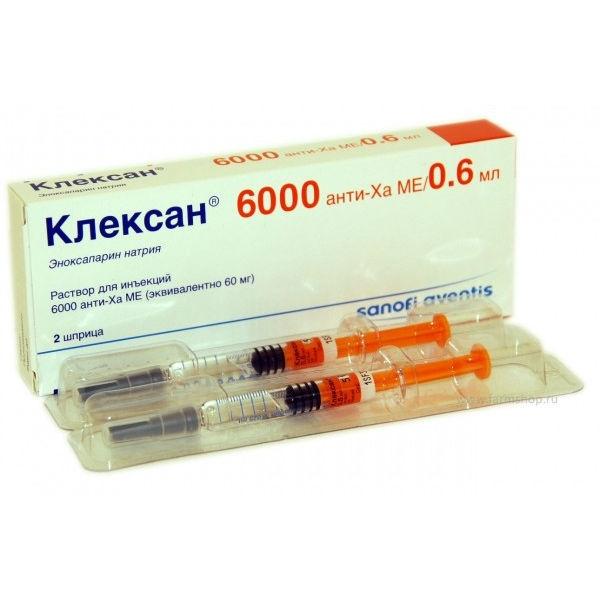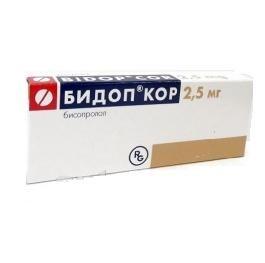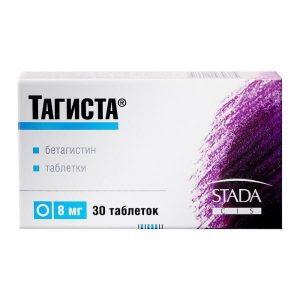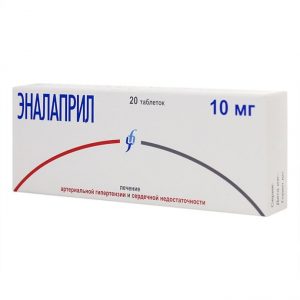Description
Latin name
CLEXANE
Release form
Injection.
Packaging
In 1 syringe 0.6 ml solution. There is 1 syringe in a blister. In a cardboard bundle 2 blisters.
Pharmacological action
Clexane is a low molecular weight heparin preparation (molecular weight about 4,500 daltons). It is characterized by high activity against coagulation factor Xa (anti-Xa activity of approximately 100 IU / ml) and low activity against coagulation factor IIa (anti-IIa or antithrombin activity of approximately 28 IU / ml).
When using the drug in prophylactic doses, it slightly changes the activated partial thromboplastin time (APTT), has practically no effect on platelet aggregation and the level of fibrinogen binding to platelet receptors.
Anti-IIa plasma activity is about 10 times lower than anti-Xa activity. The average maximum anti-IIa activity is observed approximately 3-4 hours after sc administration and reaches 0.13 IU / ml and 0.19 IU / ml after repeated administration of 1 mg / kg of body weight with a double administration and 1.5 mg / kg of body weight with a single introduction accordingly.
The average maximum anti-Xa plasma activity is observed 3-5 hours after s / c administration of the drug and is approximately 0.2, 0.4, 1.0 and 1.3 anti-XA ME / ml after s / c administration of 20, 40 mg and 1 mg / kg and 1.5 mg / kg, respectively.
Indications
– Prevention of venous thrombosis and thromboembolism, especially in orthopedics and general surgery.
– Prevention of venous thrombosis and thromboembolism in patients with acute therapeutic diseases who are in bed (chronic heart failure of functional class III or IV according to NYHA classification, acute respiratory failure, acute infection, acute rheumatic diseases combined with one of the risk factors for venous thrombosis )
– Treatment of deep vein thrombosis in combination with or without pulmonary embolism.
– Treatment of unstable angina and myocardial infarction without Q wave in combination with acetylsalicylic acid.
– Prevention of thrombosis in the extracorporeal circulation system during hemodialysis.
Contraindications
– Conditions and conditions for which there is a high risk of bleeding: – Threatening abortion.
– Aneurysm of the cerebral vessels or stratified aortic aneurysm (with the exception of Surgery).
– Hemorrhagic stroke.
– Uncontrolled bleeding.
– Severe enoxaparin- or heparin-induced thrombocytopenia.
It is used with caution in cases of hemostasis disorders, including: hemophilia, thrombocytopenia, hypocoagulation, von Willebrand disease.
The company does not have data on the clinical use of the drug Clexane in the following conditions: active tuberculosis, radiation therapy (recently conducted).
Use during pregnancy and lactation
Clexane should not be used during pregnancy unless the intended benefit to the mother outweighs the potential risk to the fetus.
There is no evidence that enoxaparin crosses the placental barrier in the second trimester, there is no information regarding the first and third trimesters of pregnancy.
When using Clexane during lactation, breast-feeding should be discontinued.
Dosage and administration
The drug is administered sc. The drug can not be entered in / m!
For the prevention of venous thrombosis and thromboembolism: patients with moderate risk (abdominal surgery) are prescribed Clexane 20-40 mg (0.2-0.4 ml) s / c 1 time / day. The first injection is performed 2 hours before surgery, patients at high risk (orthopedic surgery) are prescribed 40 mg (0.4 ml) s / c 1 time / day. and the first dose is administered 12 hours before surgery or 30 mg (0.3 ml) s / c 2 times / day. with the introduction of 12-24 hours after surgery.
Duration of treatment with Clexane is 7-10 days. If necessary, therapy can be continued until there is a risk of thrombosis or embolism (for example, in orthopedics, Clexane is prescribed at a dose of 40 mg 1 time / day for 5 weeks).
For the prevention of venous thrombosis in patients with acute therapeutic conditions who are in bed, 40 mg is prescribed 1 time / day. within 6-14 days.
For the treatment of deep vein thrombosis, 1 mg / kg sc is administered every 12 hours (2 times / day) or 1.5 mg / kg 1 time / day. In patients with complicated thromboembolic disorders, the drug is recommended to be used at a dose of 1 mg / kg 2 times / day. The average duration of treatment is 10 days. It is advisable to immediately begin treatment with indirect anticoagulants, while therapy with Clexane must be continued until a sufficient anticoagulant effect is achieved, i.e. INR should be 2.0-3.0.
In case of unstable angina pectoris and myocardial infarction without Q wave, the recommended dose of Clexane is 1 mg / kg sc every 12 hours. Acetylsalicylic acid is prescribed at a dose of 100-325 mg 1 time / day. The average duration of therapy is 2-8 days (until stabilization of the clinical condition of the patient).
To prevent the formation of a blood clot in the extracorporeal circulation system during hemodialysis, the dose of Clexane averages 1 mg / kg body weight. At high risk of bleeding, the dose should be reduced to 0.5 mg / kg body weight with double vascular access or 0.75 mg / kg with a single vascular access. With hemodialysis, the drug should be injected into the arterial area of the shunt at the beginning of the hemodialysis session. A single dose is usually enough for a four-hour session, however, if fibrin rings are detected with longer hemodialysis, you can additionally introduce the drug at the rate of 0.5-1 mg / kg body weight.
Use in patients with impaired renal function: In case of impaired renal function, it is necessary to adjust the dose of the drug depending on QC. With CC less than 30 ml / min, Clexane is administered at the rate of 1 mg / kg body weight 1 time / day. for therapeutic purposes and 20 mg 1 time / day. with a preventive purpose. The dosage regimen does not apply to cases of hemodialysis. With CC more than 30 ml / min, dose adjustment is not required, however, laboratory monitoring of therapy should be carried out more carefully.
Rules for the introduction of the solution: it is advisable to carry out the injection in the patient’s supine position. Clexane is administered deeply subcutaneously. When using pre-filled syringes of 20 mg and 40 mg before injection, it is not necessary to remove air bubbles from the syringe in order to avoid loss of the drug. Injections should be carried out alternately in the left or right upper lateral or lower lateral parts of the anterior abdominal wall.
The needle must be inserted vertically full length into the skin, holding the fold of skin between the thumb and forefinger. A skin fold is released only after completion of the injection. Do not massage the injection site after drug administration.
Side effects of
Side effects of enoxaparin sodium have been studied in more than 15,000 patients participating in clinical trials. Prevention of venous thrombosis and embolism during general surgical and orthopedic operations – 1776 patients.
Prevention of venous thrombosis and embolism in patients on bed rest due to acute therapeutic diseases – 1169 patients. Treatment of deep vein thrombosis with pulmonary thromboembolism or without pulmonary thromboembolism – 559 patients. Treatment of unstable angina pectoris and myocardial infarction without Q wave – 1578 patients.
Treatment of myocardial infarction with ST segment elevation – 10176 patients. The mode of administration of enoxaparin sodium was different depending on the indications. For the prevention of venous thrombosis and embolism during general surgical and orthopedic operations or in patients on bed rest, it was 40 mg subcutaneously once.
When treating deep vein thrombosis with or without pulmonary embolism, patients received enoxaparin sodium at a rate of 1 mg / kg body weight subcutaneously every 12 hours or 1.5 mg / kg body weight subcutaneously once a day. In the treatment of unstable angina pectoris and myocardial infarction without Q wave, the dose of sodium enoxaparin was 1 mg / kg body weight subcutaneously every 12 hours, and in the case of myocardial infarction with ST segment elevation, 30 mg bolus was administered, followed by 1 mg / kg body weight subcutaneously every 12 hours.
Side effects were classified by frequency as follows: very frequent ( 1/10), frequent ( 1/100 – – Bleeding
Bleeding was the most common side effect. It occurred in 4.2% of cases and was considered significant if accompanied by a decrease hemoglobin content of 2 g / l or more, required transfusion of 2 or more doses of blood components, as well as if it was retroperitoneal or intracranial. Some of these cases were fatal.
As with the use of other anticoagulants, bleeding may occur, especially if there are risk factors that contribute to the development of bleeding, during invasive procedures or the use of drugs that violate hemostasis (see “Special Instructions” and “Interactions with Other Drugs”).
Very frequent – bleeding in the prevention of venous thrombosis in surgical patients and the treatment of deep vein thrombosis with or without thromboembolism.
Frequent – bleeding in the prevention of venous thrombosis in patients on bed rest and in the treatment of angina pectoris, myocardial infarction without Q wave and myocardial infarction with ST segment elevation.
Infrequent – retroperitoneal hemorrhages and intracranial bleeding in patients treating deep vein thrombosis with or without thromboembolism, as well as myocardial infarction with ST segment elevation.
Rare – retroperitoneal hemorrhages in the prevention of venous thrombosis in surgical patients and in the treatment of angina pectoris, myocardial infarction without Q wave.
When using Clexan with spinal / epidural anesthesia and postoperative use of penetrating catheters, rare cases of the formation of neuroaxial neurological disorders that led to various severity, including long-lasting or irreversible paralysis (see. “Special instructions”).
– Thrombocytopenia and thrombocytosis
Very frequent – thrombocytosis in the prevention of venous thrombosis in surgical patients and in the treatment of deep vein thrombosis with or without thromboembolism.
Frequent – thrombocytopenia in the prevention of venous thrombosis in surgical patients and the treatment of deep vein thrombosis with or without thromboembolism, as well as in myocardial infarction with ST segment elevation.
Infrequent – thrombocytopenia in the prevention of venous thrombosis in patients on bed rest and in the treatment of angina pectoris, myocardial infarction without Q wave.
Very rare – autoimmune thrombocytopenia in myocardial infarction with ST segment elevation.
In rare cases, the development of autoimmune thrombocytopenia in combination with thrombosis has been reported. In some of them, thrombosis was complicated by organ infarction or limb ischemia (see section “Special instructions”).
– Other
Very often – increased activity of “liver” transaminases.
Often – allergic reactions, urticaria, itching, redness of the skin, bruising and pain at the injection site.
Infrequently – skin (bullous rashes), inflammatory reaction at the injection site, skin necrosis at the injection site.
Rarely – anaphylactic and anaphylactoid reactions, hyperkalemia. Skin necrosis may develop at the injection site, preceded by the appearance of purpura or erythematous painful papules. In these cases, therapy with Clexane should be discontinued.
The formation of solid inflammatory nodules-infiltrates at the injection site of the drug is possible, which disappear after a few days and are not grounds for drug withdrawal.
Drug Interaction
When co-administered with Klexan with drugs that affect hemostasis (salicylates / except for unstable angina and myocardial infarction without ST-segment elevation), other NSAIDs / including ketorolac /, dextranic, , anticoagulants, antiplatelet agents (including glycoprotein receptor antagonists IIb / IIIa), hemorrhagic complications may develop.
If the use of such a combination cannot be avoided, enoxaparin should be used under close control of blood coagulation.
The use of enoxaparin sodium and other low molecular weight heparins should not be alternated since they differ from each other by production method, molecular weight, specific anti-XA activity, units and doses.
These drugs therefore have different pharmacokinetics, biological activity (anti-IIa activity and platelet interaction).
The Klexan solution cannot be mixed with other drugs.
overdose
Symptoms: accidental overdose with I / O, extracorporeal or p / to administration can lead to hemorrhagic complications. When taken inside, even in large doses, the absorption of the drug is unlikely.
Treatment: Slow in / in administration of protamine sulfate, the dose of which is dependent on the dose of Klexane administered, is shown as a neutralizing agent.
It should be borne in mind that 1 mg of protamine neutralizes the anticoagulant effect of 1 mg enoxaparin, if Klexan was administered no more than 8 hours before the introduction of protamine. 0.5 mg of protamine counteracts the anticoagulant effect of 1 mg of Klexan if it is given more than 8 hours ago or when a second dose of protamine is required.
If, after the introduction of Klexan, more than 12 hours have passed, then the introduction of protamine is not required. However, even with the introduction of high doses of protamine sulfate, the anti-XA activity of Clexan is not completely neutralized (by a maximum of 60%).
Storage conditions
The drug should be stored at a temperature not exceeding 25 ° C.
Expiration
3 years.
Deystvuyuschee substances
noksaparyn sodium
dosage form
dosage form
injection
Sanofi-Aventis, France




